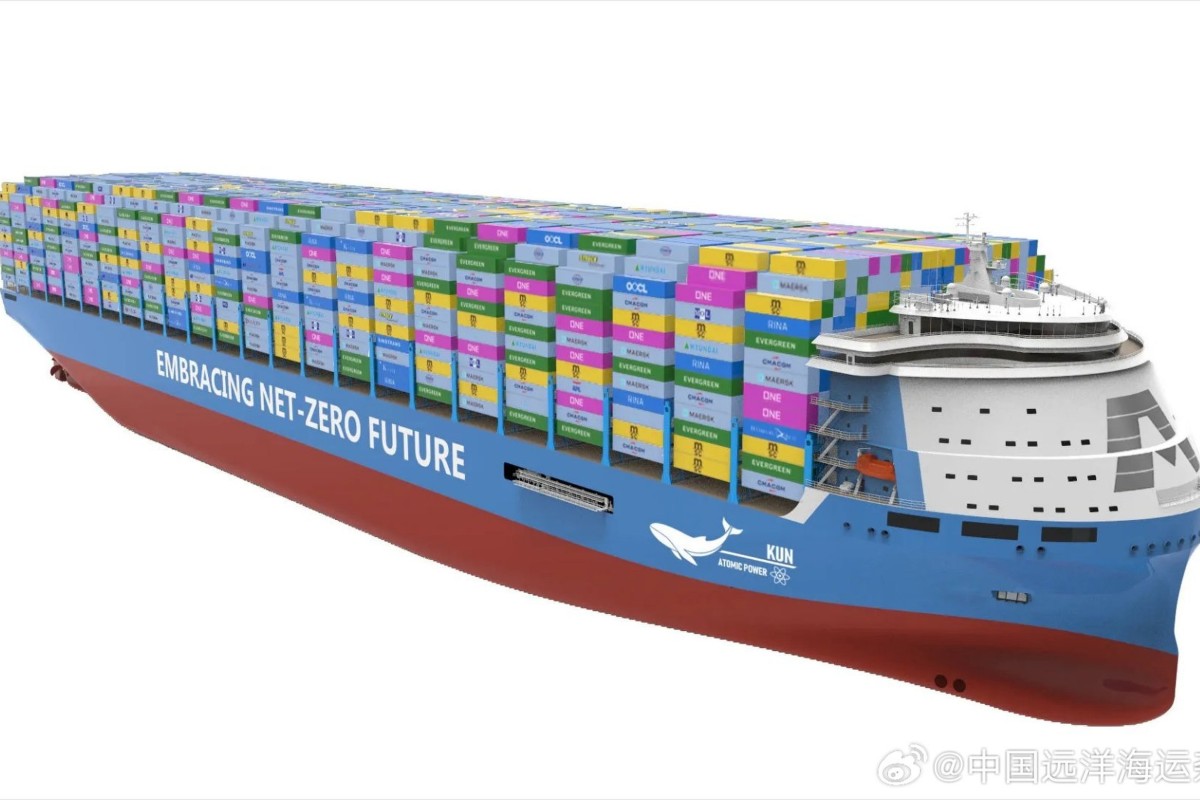Here the KUN-24AP container ship would be a massive departure with its molten salt reactor. Despite this seemingly odd choice, there are a number of reasons for this, including the inherent safety of an MSR, the ability to refuel continuously without shutting down the reactor, and a high burn-up rate, which means very little waste to be filtered out of the molten salt fuel. The roots for the ship’s reactor would appear to be found in China’s TMSR-LF program, with the TMSR-LF1 reactor having received its operating permit earlier in 2023. This is a fast neutron breeder, meaning that it can breed U-233 from thorium (Th-232) via neutron capture, allowing it to primarily run on much cheaper thorium rather than uranium fuel.
An additional benefit is the fuel and waste from such reactors is useless for nuclear weapons.
Another article with interviews: https://gcaptain.com/nuclear-powered-24000-teu-containership-china/
Here the KUN-24AP container ship would be a massive departure with its
molten salt reactor. Despite this seemingly odd choice, there are a number of reasons for this, including the inherent safety of an MSR, the ability to refuel continuously without shutting down the reactor, and a high burn-up rate, which means very little waste to be filtered out of the molten salt fuel. The roots for the ship’s reactor would appear to be found in China’s TMSR-LF program, with the TMSR-LF1 reactor having received its operating permit earlier in 2023. This is a fast neutron breeder, meaning that it can breed U-233 from thorium (Th-232) via neutron capture, allowing it to primarily run on much cheaper thorium rather than uranium fuel.Molten Salt Reactors are so cool. It’s wild how little they’re talked about, given how much of a game changer they seem to be – basically every mine on the planet is carting out tonnes of thorium. The last time I heard about this, it was still just a theoretical design. But now it’s proven and they’re putting it on ships? Fuck yeah!
Naturally, there is a lot of concern when it comes to anything involving ‘nuclear power’. Yet many decades of nuclear propulsion have shown the biggest risk to be the resistance against nuclear marine propulsion, with a range of commercial vessels (Mutsu, Otto Hahn, Savannah) finding themselves decommissioned or converted to diesel propulsion not due to accidents, but rather due to harbors refusing access on ground of the propulsion, eventually leaving the Sevmorput [Russian nuclear powered cargo ship] as the sole survivor of this generation outside of vessels operated by the world’s naval forces.
These same naval forces have left a number of sunken nuclear-powered submarines scattered on the ocean floor, incidentally with no ill effects.that seems… convenient. how do they know?
edit; and what’s with the coloured words, i was using the
backtick(`) to highlightthat seems… convenient. how do they know?
Because there has been over 50 years of extensive research?
https://www.iaea.org/resources/databases/marine-radioactivity-information-system-maris
We actually take samples and monitor those sunken reactors: https://www.hi.no/en/hi/news/2019/july/researchers-discovered-leak-from-komsomolets.
Water is a fantastic way of insulating radiation. Nuclear plants store used fuel rods in a pool that’s only 20-30 feet deep, and you could theoretically swim to within a few feet of the highly radioactive rods without issue.
A melted down nuclear reactor at the bottom of the ocean has zero ecological impact. It’s bizarre to consider, but it’s been backed up by extensive research.
Yeah but I’m worried about the radioactive metals themselves bioaccumulating in the surrounding wildlife.
that seems… convenient. how do they know?
The primary issue with land-based reactors is cooling to prevent it from reacting uncontrollably. If you’re sinking something to the bottom of the ocean there is no cooling problem.
Land reactors pretty much need to be on rivers, and from what i understand severe droughts forceshutdowns in europe a year or two ago.
edit; and what’s with the coloured words, i was using the backtick (`) to highlight
That’s the code highlight markup, which probably has some basic syntax filtering to pick out common keywords. Floor is a common math function, number could conceivably be a value used for a check in some languages, but I’m not sure why “on,” “no,” “left,” or “a” are highlighted and can only guess those are meaningful words in some languages.
Just to see what else it picks up:
That's the code highlight markup, which probably has some basic syntax filtering to pick out common keywords. Floor is a common math function, number could conceivably be a value used for a check in some languages, but I'm not sure why "on," "no," "left," or "a" are highlighted and can only guess those are meaningful words in some languages.left a numberleftanumbera numberleft aonnofloor a numberThis just raises more questions than it answered. Like I can kind of see it doing some kind of heuristic to guess what’s a function or variable name, but it’s not clear what looks like what to it. I guess that’s the issue with using it on normal text instead of just for code, where I’m assuming it highlights things rather more sensibly.
Typical of bazinga brains to mald in the comments about any Chinese advancement.
Yeah. Annoying because nuclear powered container ships are the only realistic way to decarbonize transoceanic shipping. When you do the math, the biofuel and e-fuel plans western shipping firms have all presented are obviously not feasible. There isn’t enough farmland on earth to produce enough feedstock for the required amount of biofuel and with e-fuels the economics don’t work out due to how much electricity is needed per liter of fuel synthesized.
I still want to see gigantic windjammers.
Got some of them in this thread too, the typical ignorant NUCULURR BAD folks who know literally nothing about power generation at all
Where are you finding the comments?
just scroll down. Hackaday in particular has been the way it is for a really long time.
Oh I only clicked the link OP provided in the comments, I see now



 I’VE BEEN SAYING THIS FOR YEARS LETS FUCKING GOOOOOOOOOOOOOOOOOO
I’VE BEEN SAYING THIS FOR YEARS LETS FUCKING GOOOOOOOOOOOOOOOOOONUCLEAR GOOD VIDEO BY ME
XI DECARBONIZE THE SEAS
your video now has 9 likes

I’m still proud of that video
safer then potentially dumping a zillion gallons of the dirtiest bunker fuel into the ocean when something goes wrong
I’d say this is a real shot across the bow for Australia, as it signals decoupling from the coal economy.
But modern container ships don’t burn coal, they burn bunker fuel which is an oil product?
Australia’s days are numbered either way with China moving towards renewables an nuclear at speed but I just don’t see the connection here.
Incidentally, Australia has huge reserves of uranium, so a nuclear economy would rely on them as well. Unless you’re using breeder reactors and/or thorium reactors.

Learn this one neat trick to decouple yourself from the hated English post-colonial dregs.
Australians hate it.
deleted by creator
IIRC the 10 largest ships in the world pump more carbon in the atmosphere than all the cars in the world, so this is pretty great!
Not carbon, but particulate pollutants or something. Ships use way less refined fuel than cars do.
Bunker oil

Give ELF anti-ship missiles
All boats should be nuclear powered, even kayaks.
Russia should’ve kept more of their nuclear ships

Good article finds. It would be really funny if Samsung enters the nuclear ship industry lol.
Considering the other options are wind power and synthetic fuels, lots of nuclear ships will probably be preferred.
Hell yeah. Should have happened in the 60 s$
I’d rather they use these massive ships for making hydrogen oxygen splitting than promoting corrosive radioactive salt nukes. And no I wont be responding to the nuclear zealots and lobyists here.
 I hope the best for China, and I hate having to pay a “China tax” save being accused of “racism” or “nationalist chauvinism”, but nukes IMO are not the way forward. Too much risk.
I hope the best for China, and I hate having to pay a “China tax” save being accused of “racism” or “nationalist chauvinism”, but nukes IMO are not the way forward. Too much risk.Where is the energy to generate hydrogen going to come from? If it were pure renewables you’d have to cover all of Xinjiang in solar panels. Also what specific issues do you have against Thorium reactors? I was led to believe that they were a much better alternative in terms of safety and waste. /gen.
deleted by creator
Yeah, it’s not great, and it doesn’t address hyper consumption. But if the treats must flow, molten salt reactors are a much better on multiple fronts - less fuel consumption when the shipping industry is a major contributor to CO2, and it’s a much safer reactor that produces way less waste compared to other types. Still dangerous, but so is a boat full of petrol based fuel if there’s an accident.
Hexbear.net, a known hangout for lobbyists

What is this “China tax” you’re talking about?
deleted by creator
Brinksmanship
Craftsmanship
and now, introducing
Containership
An additional benefit is the fuel and waste from such reactors is useless for nuclear weapons.
And here we have the reason the US has not been using throium reactors despite their safety, easy to procure fuel, and much safer waste materials.



















